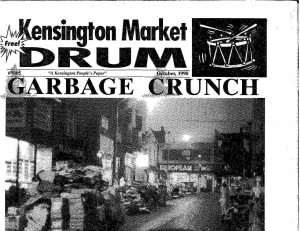By Beth Macdonell
In the early 1990s, residents and merchants of Kensington Market successfully organized to increase garbage pickup days from two to three days a week.
Now, it will be seen if the newly formed Kensington Business Improvement Area (BIA), will be able to make a similar move by reversing a decision by Toronto Solid Waste to cut garbage pickup in the market from two days to one.
“I get an earful about it every time I walk through the market,” said Councillor Adam Vaughan (Ward 20, Trinity-Spadina). “It was a decision that staff made and we have been playing catch up ever since.”
Vaughan said he was notified about the scaled-back garbage collection shortly before the Nov. 1 decision in an email.
Rob Orpin, director of collection operations, said the decision to harmonize commercial collection was made citywide. He said it was reviewed by Public Works and approved by city council.
Under the new pick up schedule, businesses can sign up for a premium organic collection five or six days a week that will cost businesses $1,200 or $1,600 a year respectively. “It works out to $4 a day. It’s a cheap way of diverting waste from landfill,” said Orpin.
“The whole premise and city explanation is three fold: It’s a cop out, a tax grab and phony as Swiss cheese with no holes,” said Ozzie Pavao, one of the founding members of the Kensington BIA and owner of Casa Acoreana. “The economy is so bad … and you want to pull another $1,200 out of us. I can’t believe it.”
Other businesses that handle food said the reduction makes no sense. “I don’t understand,” said Alfonso Segovia, one of the owners of Segovia Meat Market (218 Augusta Ave.). “For some reason, the city doesn’t pay attention to us.”
Segovia’s family has been doing business in the market since 1978. He said he’s perplexed how health issues alone didn’t motivate the city to keep the two pickup days. The more garbage, the more “bacteria there is, rodents—these are big problems. I can’t leave anything outside.”
To cope, Segovia stores his garbage indoors in sealed bins until garbage day.
“I could never wait a week for garbage pickup”, said Kim Choo, owner of the New Seaway Fish Market (195 Baldwin St.). He said he has so much garbage, he can’t store it in bins. Instead, he and a group of other businesses pay for private garbage pickup. “I could afford to hire another worker, if the city picked up my garbage,” said Choo.
The problem goes all the way back to when Kensington grew into a market, said David Perlman, a resident in the market for the past 25 years and the former publisher of the Kensington Drum, a community newspaper in print from 1986 to 1996 which followed the battle to increase garbage collection in the paper’s monthly column “Garbage Crunch.”
Kensington Market started as a residential neighbourhood and eventually “people just decided, this is where I’m going to have my store and this is where I am going to shop,” said Perlman. He said the lanes and the narrow streets were never intended to be a business area, which is one of the reasons garbage collection issues linger today. It took years for the city even to recognize Kensington as a mixed-use area, which made getting appropriate garbage collection difficult.
What’s striking today is that in contrast to the days when Perlman covered garbage collection in the Drum, there are a lot more restaurants and bars open late, changing the garbage pick up needs in the market.
But the ability of the BIA to drive change and come up with a solution is debatable.
“There are so many stores and hardly anyone goes to the meetings,” said Segovia, referring to meetings among storeowners over garbage issues in the past.
Perlman, who is also a founding member of the Kensington Market Action Committee, is worried the BIA may create a wedge between storeowners and residents in the market. “This BIA loses the notion that we are all ‘people of the market.’”
Back in the early 1990s, “it was a common front,” he said. For example, residents don’t want the noise of garbage trucks going through the neighbourhood, he said.
Still, Perlman says Vaughan has really supported the BIA and admires the work of the councillor. “This is an issue for people to sink their teeth into. It will be interesting to see what comes of it.”
Pavao is more confident that the BIA will make a difference.
“We (the BIA) can voice our opinion. We can try and make them change their mind. We have to stand up to these so-called representatives of the taxpayer,” he said.
“We need a made-in-Kensington solution,” said Vaughan. “It can’t operate along suburban guidelines.”
Choo suggested the city open a 24-hour drop-off centre where merchants could bring excess garbage for an extra fee. At least, this way he said, it would give businesses another option to keep their establishments and the streets cleaner.
In the meantime, Orpin thinks stores should give the new system a chance and time.

